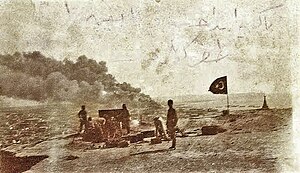
The Transcaucasian Democratic Federative Republic was a short-lived state in the Caucasus that included most of the territory of the present-day Armenia, Azerbaijan and Georgia, as well as parts of Russia and Turkey. The state lasted only for a month before Georgia declared independence, followed shortly after by Armenia and Azerbaijan.

The Azerbaijan Democratic Republic, also known as the Azerbaijan People's Republic, was the first secular democratic republic in the Turkic and Muslim worlds. The ADR was founded by the Azerbaijani National Council in Tiflis on 28 May 1918 after the collapse of the Transcaucasian Democratic Federative Republic, and ceased to exist on April 28, 1920. Its established borders were with Russia to the north, the Democratic Republic of Georgia to the north-west, the Republic of Armenia to the west, and Iran to the south. It had a population of around 3 million. Ganja was the temporary capital of the Republic as Baku was under Bolshevik control. The name of "Azerbaijan" which the leading Musavat party adopted, for political reasons, was, prior to the establishment of the Azerbaijan Democratic Republic in 1918, exclusively used to identify the adjacent region of contemporary northwestern Iran.
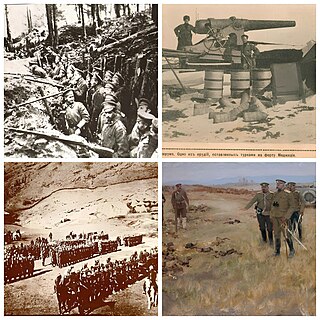
The Caucasus campaign comprised armed conflicts between the Russian Empire and the Ottoman Empire, later including Armenia, Azerbaijan, Georgia, the Mountainous Republic of the Northern Caucasus, the German Empire, the Central Caspian Dictatorship, and the British Empire, as part of the Middle Eastern theatre during World War I. The Caucasus campaign extended from the South Caucasus to the Armenian Highlands region, reaching as far as Trabzon, Bitlis, Mush and Van. The land warfare was accompanied by naval engagements in the Black Sea.

The Islamic Army of the Caucasus was a military unit of the Ottoman Empire formed on July 10, 1918. The Ottoman Minister of War, Enver Pasha, ordered its establishment, and it played a major role during the Caucasus Campaign of World War I.
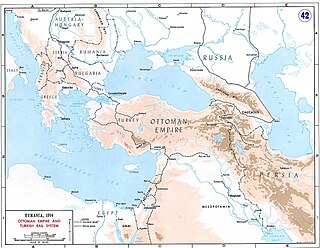
Dunsterforce was an Allied military force, established in December 1917 and named after its commander, Major-General Lionel Dunsterville. The force comprised fewer than 350 Australian, New Zealand, British and Canadian officers and NCOs, who were drawn from the Western and Mesopotamian fronts. The force was intended to organise local units in northern Iran (Persia) and South Caucasus, to replace the Tsarist army that had fought the Ottoman armies in Armenia. The Russians had also occupied northern Iran in co-operation with the British occupation of southern Iran, to create a cordon to prevent German and Ottoman agents from reaching Central Asia, Afghanistan and India.
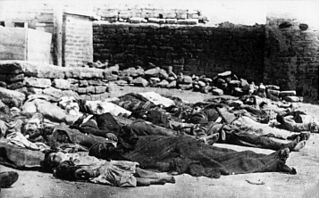
The March Days or March Events was a period of inter-ethnic strife and clashes which took place between 30 March – 2 April 1918 in the city of Baku and adjacent areas of the Baku Governorate of the Transcaucasian Commissariat.
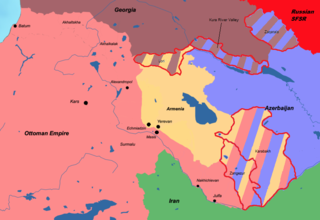
The Treaty of Batum was signed in Batum on 4 June 1918, between the Ottoman Empire and the three Transcaucasian states: the First Republic of Armenia, the Azerbaijan Democratic Republic and the Democratic Republic of Georgia. It was the first treaty of the First Republic of Armenia and the Azerbaijan Democratic Republic and had 14 articles.

The occupation of Western Armenia by the Russian Empire during World War I began in 1915 and was formally ended by the Treaty of Brest-Litovsk. It was sometimes referred to as the Republic of Van by Armenians. Aram Manukian of the Armenian Revolutionary Federation was the de facto head until July 1915. It was briefly referred to as "Free Vaspurakan". After a setback beginning in August 1915, it was re-established in June 1916. The region was allocated to Russia by the Allies in April 1916 under the Sazonov–Paléologue Agreement.

The Armenian-Azerbaijani war (1918–1920) was a conflict that took place in the South Caucasus in regions with a mixed Armenian-Azerbaijani population, broadly encompassing what are now modern-day Azerbaijan and Armenia. It began during the final months of World War I and ended with the establishment of Soviet rule.

The Battle of Baku took place in August and September 1918 between the Ottoman–Azerbaijani coalition forces led by Nuri Pasha and Bolshevik–ARF Baku Soviet forces, later succeeded by the British–Armenian–White Russian forces led by Lionel Dunsterville and saw Soviet Russia briefly re-enter the war. The battle took place during World War I, was a conclusive part of the Caucasus Campaign, but a beginning of the Armenian–Azerbaijani War.
The September Days refers to a period during the Russian Civil War in September 1918 when Armenian inhabitants of Baku were massacred by Enver Pasha's Army of Islam and their local Azeri allies when they captured Baku, the soon-to-be capital of the Azerbaijan Democratic Republic. According to most estimates, approximately 10,000 ethnic Armenians were killed in the violence, although some sources claim the number to be as high as 30,000. The massacre is said by some scholars to have been carried out in retaliation for the earlier March Days, in which Dashnak and Bolshevik forces had massacred Azerbaijani inhabitants of the city in March 1918. It was the last major massacre of World War I.

Akaki Chkhenkeli was a Georgian Social Democratic politician and publicist who acted as one of the leaders of the Menshevik movement in Russia and Georgia. In 1918 he served as the prime minister and foreign minister of the Transcaucasian Democratic Federative Republic, and then became foreign minister of the Democratic Republic of Georgia. In 1921 he was appointed the Georgian Minister to France, though was unable to serve as the Red Army invaded Georgia. His younger brother was the linguist Kita Tschenkéli.
The Treaty of Poti was a bilateral agreement between the German Empire and the Democratic Republic of Georgia in which the latter accepted German protection and recognition. The agreement was signed, on 28 May 1918, by General Otto von Lossow for Germany and by Foreign Minister Akaki Chkhenkeli for Georgia. Concluded at the Georgian Black Sea port of Poti, the treaty came only two days after Georgia proclaimed independence, becoming the newly independent republic's first-ever international treaty.

The German Caucasus expedition was a military expedition sent in late May 1918, by the German Empire to the formerly Russian Transcaucasia during the Caucasus Campaign of World War I. Its prime aim was to stabilize the pro-German Democratic Republic of Georgia and to secure oil supplies for Germany by preventing the Ottoman Empire from gaining access to the oil reserves near Baku on the Absheron Peninsula.

The Transcaucasian Commissariat was established at Tbilisi on 11 November 1917, as the first government of the independent Transcaucasia following the October Revolution in Petrograd. The Commissariat decided to strengthen the Georgian–Armenian–Azerbaijani union by convoking a Diet or general assembly (Sejm) in January 1918. It declared independence from Soviet Russia and formed the Transcaucasian Democratic Federative Republic after being faced with the threat of being overrun by the Ottoman invasion.

The Trebizond Peace Conference was a conference held between 14 March and 13 April 1918 in Trebizond between the Ottoman Empire and a delegation of the Transcaucasian Diet and government. The opening session was on 14 March 1918. The representatives were Rear-Admiral Hüseyin Rauf Bey for the Ottoman Empire, and Akaki Chkhenkeli, Khalil bey Khasmammadov, Alexander Khatisian etc. as the Transcaucasian delegation.

The Transcaucasian Seim was a representative and legislative body of state power in the Transcaucasus, convened by the Transcaucasian Commissariat in Tiflis on 23 February 1918. Its members consisted of Russian Constituent Assembly deputies elected in Transcaucasia, as well as representatives of the various political parties of Transcaucasia. Its chairman was Nikolay Chkheidze of the Social Democratic Party of Georgia.

The Declaration of Independence of Azerbaijan is the pronouncement adopted by the Azerbaijani National Council meeting in Tiflis on 28 May 1918, declaring the independence of the Azerbaijan Democratic Republic.
With the outbreak of hostilities in the Caucasus as part of World war I, Azerbaijan was also involved in the war, being part of the Russian Empire. Baku oil was of particular importance.
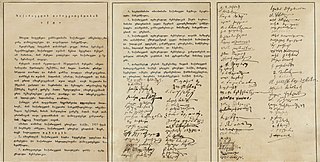
The Georgian Declaration of Independence was the declaration of independence of the Democratic Republic of Georgia on 26 May 1918. It established a Georgian state from the Transcaucasian Democratic Federative Republic, a federation between Armenia, Azerbaijan, and Georgia in the wake of the 1917 Russian Revolution. It was proclaimed in Tiflis, the main city of Georgia and the new capital of Georgia.
